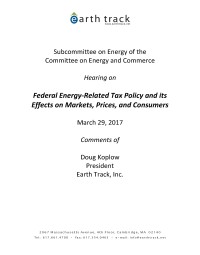Earth Track Written Testimony on Federal Energy-Related Tax Policy and its Effects on Markets, Prices, and Consumers

Within the United States, the cost of energy subsidies to taxpayers is both substantial and often not properly documented. Regular review to evaluate the fiscal costs of these policies; their impact on market structure, competiveness, and environmental quality; and their ability to achieve stated goals is prudent.
My comments focus on three main issues:
- All subsidy mechanisms matter. In order to optimize energy subsidy policy, one needs to look at all mechanisms the government is using to transfer value to market participants, not just tax subsidies.
- Subsidies to conventional fuels are often more difficult to quantify than those to renewables, but are nonetheless large and long-standing. Production tax credits, cash grants, and purchase price premiums comprise the majority of government support to large renewable resources such as wind and solar. These interventions are easier to quantify than the credit or risk subsidies, state ownership, lease competitiveness, or upstream tax breaks that dominate the subsidy picture for conventional fuels. Ignoring these more complex instruments, however, will produce a skewed view of government interventions over time and impede development of an optimal reform strategy.
- Simple changes to policy structures can greatly improve subsidy efficiency and transparency. There are more and less distortionary ways to provide subsidies to targeted activities. Where subsidy elimination is not possible, reforms can and should restructure both existing and new subsidies to ensure that more efficient approaches are used.

